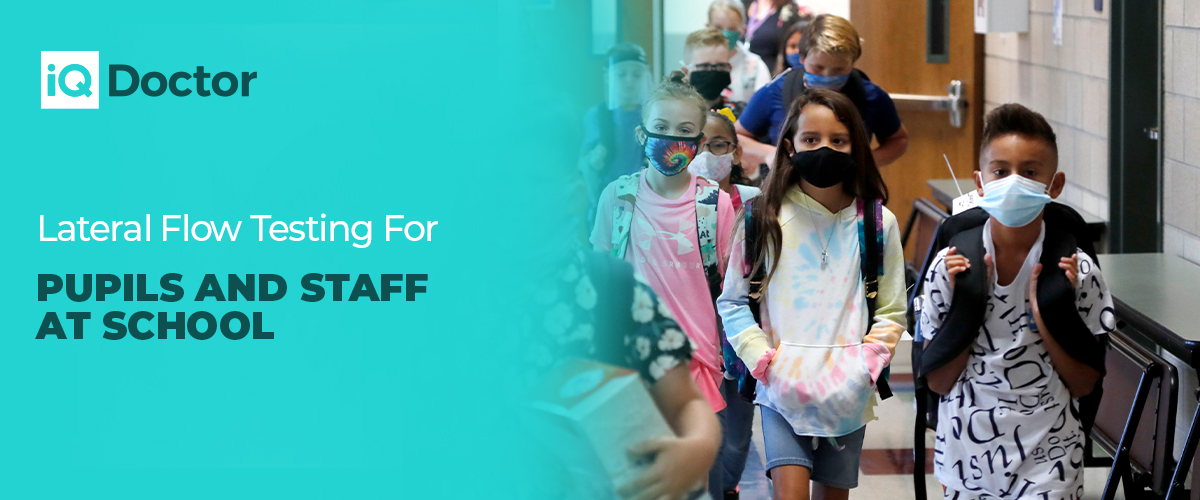Lateral Flow Testing For Pupils and Staff At School
02 November, 2021 | Jane Thomas - Marketing

As schools open up throughout the UK, active COVID-19 testing has become the key to keeping pupils and staff safe. Rapid Lateral Flow testing has emerged as a quick and easy way to test, and it is now an important defence to keep COVID-19 at bay and avoid another lockdown.
A Hotspot For Infection
The UK government has lifted all prior pandemic related restrictions on schools and pupils are therefore now able to attend in person. However, this does not change the fact that schools are a hotspot for infection. Many pupils enter and leave the building all day while being packed into small and insufficiently ventilated rooms. All these factors can easily lead to a break out of infections.
Another outbreak of COVID-19 could severely restrict teaching and further delay educational progress. Yet, this is what community members have been asked to do to keep themselves and their environment safe.
Bi-weekly Lateral Flow Testing testing is one of the primary tools we have to identify potential infections and minimise the spread of COVID-19 in our schools.
Bi-Weekly Testing
All staff and secondary school pupils coming to the campus are requested to administer a self-test bi-weekly, regardless of their symptoms, because many COVID-19 carriers can be asymptomatic. Up to one in three people with COVID-19 do not show any symptoms.
It is also important to remember that bi-weekly tests do not change the rules regarding social distancing and face masks. Pupils and staff should still wear face masks in crowded open spaces. These tests help observe the effectiveness of all safety precautions at the school but do not negate the possibility of infections spreading amongst the staff and pupils.
Currently, the required testing method is Lateral Flow Tests for school staff and students. The Lateral Flow Test is a much faster and cheaper test for identifying COVID-19 infection. In addition, it is a better application for wide screening of potential infections. Extensive research by public health institutions shows us that Lateral Flow Tests are very accurate in identifying infection. Although it is not as sensitive as the Polymerase Chain Reaction (PCR) test, it is still a good fit for a bi-weekly test.
The Lateral Flow Test for school staff and students is a self swab test that does not need to be sent to a laboratory. However, school staff and pupils are strongly advised to read all instructions on their given test. After completing the swab, they can get their test within 15 to 30 minutes. The Lateral Flow test is easily self-administered, but it is advised that younger students do it under the supervision of an adult.
Pupils and school staff who are not required to be on campus every day should only have a test report ready 24 hours before coming to the campus.
The government also advises secondary schools to have a small on-site testing facility for students who cannot administer self-tests at home. In addition, schools should have a dedicated trained staff team responsible for conducting tests on-site.
Primary age pupils are not to be tested as the government health officials have advised that there are limited benefits of conducting Lateral Flow Tests on such a young population.
Lateral Flow Test for school staff and students might be available through the school’s sources. You can check the school’s website or contact the administration for more information. The tests provided through your institution should only be used by staff and students. Lateral Flow Tests for staff families can be ordered independently through local pharmacies. You can also order a Lateral Flow Test from our website.
Testing Positive For COVID-19
If a student or staff is tested positive through the Lateral Flow Test, they must self isolate for ten days. They must also report their result to the school and the National Health Service (NHS) website so that close contacts can be notified and asked to self-isolate.
During their isolation, they will have to take the Polymerase Chain Reaction (PCR) test to confirm their infection. If it is still positive, they are to remain in isolation for the remainder of 10 days. Then, before returning to campus, they must take another Lateral Flow Test to confirm that they are no longer infected.
Students and staff members who are fully vaccinated will not need to isolate themselves if they have been in close contact with an infected individual. However, they will still need to take a PCR test.
Although on-campus education is a priority, an exception will be made for students who cannot attend classes due to COVID, whether it is a possible infection from a positive Lateral Flow Test result or confirmed by the PCR test. However, these pupils can attend their classes online until their isolation period ends.
Contingency Plans
The Department For Education (DFE) has set some thresholds, which entail taking extra steps to manage the transmission of COVID-19 if it spreads too much. The thresholds are:
5 children, pupils, students or staff, who are likely to have mixed closely, test positive for COVID-19 within 10 days;
10% of children, pupils, students or staff who are likely to have mixed closely and test positive for COVID-19 within 10 days
Some extra steps the school may take include increased testing, reintroduction of remote learning, increased social distancing and wider application of face covering.
Consent And Privacy
The bi-weekly tests are not mandatory for students and staff attending regular classes but are highly recommended by the government. Testing is done voluntarily, and schools are encouraged to provide medical consent forms and inform all staff and pupils regarding taking the Lateral Flow Tests. Before giving consent, the school will provide a privacy notice to all pupils and staff. The privacy notice will contain information about what kind of personal data they require and how the government will use their data. For students under 16, their forms must be signed by a parent or guardian. The school will only share the data with the relevant authorities. The NHS wants the result data to feed into the national database, which allows the government to detect any sudden increase in infections, and thus makes it possible to implement strategies to contain the infection promptly.
Reviewed By

Omar El-Gohary
The superintendent and lead pharmacist - registration number 2059792.
Omar is passionate about developing healthcare technology to empower our patients.
Related Posts
Tags
No Tags Available


